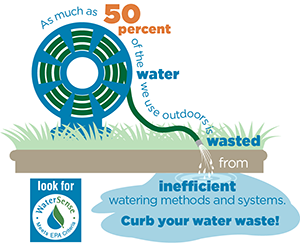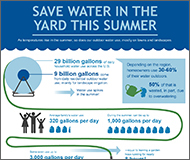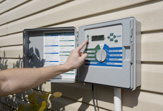Tips for Watering Wisely
Tired of dragging out the hose every day or letting your sprinkler cool off the sidewalk? The following tips can help you water much less—and more wisely.
Sprinkler Spruce–Up
When it comes to a home's irrigation system, a little maintenance goes a long way. Before you ramp up your watering efforts, spruce up your irrigation system by remembering four simple steps—inspect, connect, direct, and select. Homes with clock timer controlled irrigation systems use about 50 percent more water outdoors than homes without irrigation systems. Your system can waste even more if it’s programmed incorrectly, a sprinkler head is pointed in the wrong direction, or you have a leak.
Simple Tips for Sprucing Up Your Sprinkler
|
Inspect. Check your system for clogged, broken or missing sprinkler heads. |
|
Connect. Examine points where the sprinkler heads connect to pipes or hoses. If water pools in your landscape or you have large wet areas, you could have a leak in your system. A leak about as small as the tip of a ballpoint pen (or 1/32nd of an inch) can waste about 6,300 gallons of water per month! |
|
Direct. Are you watering the driveway, house, or sidewalk instead of your yard? Redirect sprinklers to apply water only to the landscape. |
|
Select. An improperly scheduled irrigation controller can waste water and money. Update your system’s watering schedule to align with the seasons, or select a WaterSense labeled weather based irrigation controller to take the guesswork out of scheduling. |
You can save even more water outdoors by incorporating water–smart landscaping principles into your landscape design. Looking for more ways to save? Check out other outdoor water–saving technologies.
Timing Is Everything
No matter what kind of yard or landscape you have, it's important to know exactly how much water your plants need before you turn on the sprinkler. Smart watering practices reduce runoff and may decrease the need for pesticides and fertilizers. Keeping the following questions in mind when you do water can help you maintain a beautiful and healthy yard without wasting water or money.
Contact your local water utility to find out exactly how much and when you should be watering in your area. Here are some guidelines to consider.
When? Avoid watering in the middle of the day when the hot sun will evaporate much of the water before it can get to thirsty plants. |
|
|
Give this a try! Place a few empty tuna cans around your lawn while you're watering and measure how long it takes your sprinkler to fill them with a half inch of water. Then, try watering that amount of time twice a week, gauge how your landscape responds, and adjust based on weather conditions. Or simplify by replacing your standard clock timer controller with a WaterSense labeled irrigation controller.
How often?
How long? |
|
|
|
Did You Know?

Manage Your Irrigation System
If your home is one of the more than 13.5 million with an in–ground irrigation system, try some of these simple strategies to reduce your water waste and protect the environment. Having a beautiful landscape doesn’t have to mean using a lot of water.
Look for the label. WaterSense labels irrigation controllers, a type of "smart" irrigation control technology that uses local weather data to determine whether your sprinkler system needs to turn on. WaterSense labeled controllers can help you save water, time, and money when compared to use of a conventional controller. Learn more about the ins and outs of upgrading your system with this smarter technology.
Adjust your irrigation system often. Get to know the settings on your irrigation controller and, if you haven't upgraded to a weather-based controller, adjust its watering schedule regularly to conform to seasonal weather conditions. A good rule of thumb—when you adjust your thermostat due to seasonal temperature changes, adjust your irrigation controller watering schedule as well. |
|
|
Set sprinklers to keep the water on the landscape and off the pavement. |
|
|
Play "zone" defense. |
|
|
Check for WaterSense! |
|
|
|
|
|
Use smart(er) technologies. |
|
|
Install low-volume micro-irrigation for gardens, trees, and shrubs. |




 What else?
What else? Inspect your irrigation system monthly.
Inspect your irrigation system monthly.
